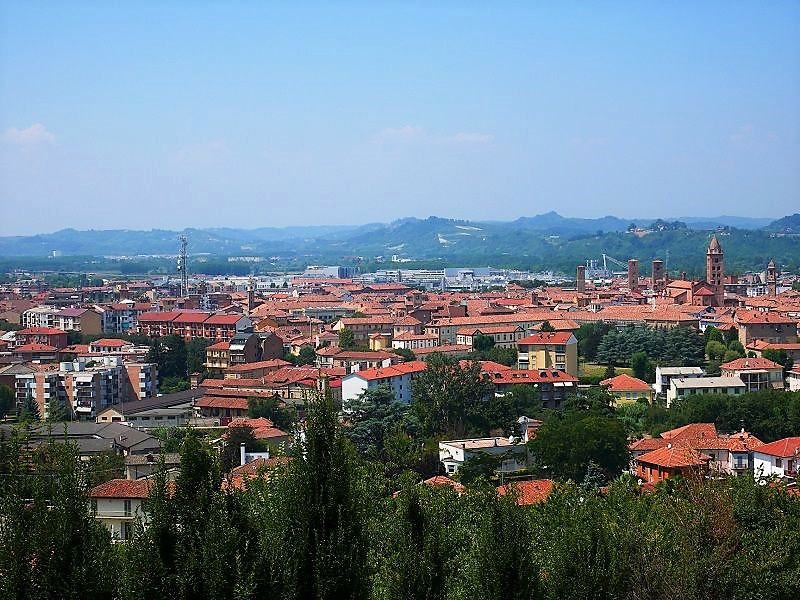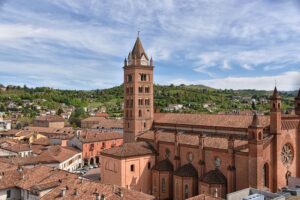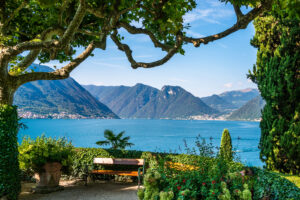Piedmont’s Chocolate, Nutella and Ferrero Rocher
Ferrero and Nutella are the pride of Alba, brands of incredible commercial success that have positively impacted the whole town, and the Italian economy.
The Piedmont region of Italy is renowned for its chocolate, especially the iconic gianduja, a creamy mixture of chocolate and hazelnuts. A chocolate tour in Piedmont is a delightful experience that Meet Piemonte Tour Operator includes in the Food and Wine Tour in Piedmont.
From gianduiotti to local pralines, and contemporary award-winning chocolate makers, guests can enjoy tours of production facilities, and indulge in tastings while learning insights into the ancient chocolate-making tradition of the region.
When in Alba, visitors often ignore how the popular chocolate delights Nutella and Ferrero Rocher were invented in Piedmont. Even less people are aware of the family name who founded the chocolate factory.
While the Ferrero family still leads the business, Piedmont’s chocolate, Nutella, and Ferrero Rocher blend in a story of great inspiration that deserves to be told.
In this article, we are also going to answer some of the most frequently asked questions: Is it possible to visit the Ferrero chocolate factory? Can we Buy Nutella from the factory’s outlet store?
Ferrero chocolate, a family story
The story unfolds with Pietro Ferrero, born in Farigliano in 1898, who moved to the nearby town of Alba in 1925. The year before he married Piera Cillario, introduced by a common friend. She soon gave birth to Michele, their son.
They shared the same passion for chocolate and sweets and they opened together a first pastry shop in the village of Dogliani. Soon after, in Via Pierino Belli, in central Alba, the first workshop was open, followed by a shop on the high street, Via Maestra.
At that time, Alba was just a rural center where people from the nearby villages would visit on market day. The Langhe Hills were poor, business opportunities were limited and shops were likely to see customers on Sundays only.
However, that was still the best place around to get more visibility.
In the following years, Pietro Ferrero and his wife engaged in a new pastry shop in Turin, spent some time in Africa, and, back in Alba, managed a bigger operation in Via Rattazzi whose production was distributed in Turin’s shops.

Piedmont’s Hazelnuts, a Chocolate Subsidiary
In the meantime, Pietro’s brother, Giovanni Ferrero, established in 1926 in Dogliani a yeast wholesaling operation. He also moved to Alba like his brother and began his retail expansion, proving once again the family’s business talent.
After World War II, by the end of 1945, the two Ferrero brothers were already back in trade. While Pietro was busy running the pastry shop in Turin, Giovanni acquired a large stock of molasses used to produce yeast.
Part of that molasses was given to Pietro who assembled it with milk powder, coconut butter, toasted hazelnuts, and chestnut flour making a cheaper alternative to chocolate.
Ferrero and Nutella, Pride of Alba and a Brilliant Intuition
This blend was sold in chunks of two kilos each, sliced by the weight. The nutty chocolate taste didn’t contain cocoa, which at that time was an out-of-reach luxury.
After a period of new attempts, trying to improve the recipe, Pietro and Piera noticed the instant success of their new confection and decided to call it “Gianduiot”.
That name was not random but very similar to the word gianduiotti, the traditional chocolate and hazelnut candy of Turin. Invented in the mid-1800s and sold by the well-established Caffarel chocolate makers, gianduiotti were very popular, and synonymous with good chocolate.
On the packaging of Pietro and Piera’s Gianduiot, was portrayed the local, good-hearted character called Gianduia. His joyful and high-spirited pantomime coming from theater repertoire, was supposed to bring optimism to Italians still struggling with the post-war recovery.

Alba, Home of Ferrero and Nutella
Alba, known as the capital of the Langhe Hills is one of the gems of southern Piedmont. On our Lake Como, Piedmont & Portofino Tour we spend a day in town, as well as the Food and Wine Tour in Piedmont.
Whether the interests of our guests are truffles, wine, or local history, Alba boasts an impressive Cathedral, medieval towers, and an elegant shopping street where the first Ferrero shop used to be.
The story of this family is one of the highlights of all our tours, and we make sure to point out the spot where the first original pastry shop used to be, as well as the modern factory located along the Tanaro River, on Strada Toppino (Via Vivaro).
Although the production site is not open to the public, it can be spotted from the highway or driving from central Alba toward the Barolo Wine Region. That is exactly the same piece of land bought by the Ferrero family soon after May 14th, 1946. That’s when the Chamber of Commerce of Cuneo officially enrolled the firm “P. Ferrero di Cillario Pierina”, from where it originated the Ferrero Group that we know today.
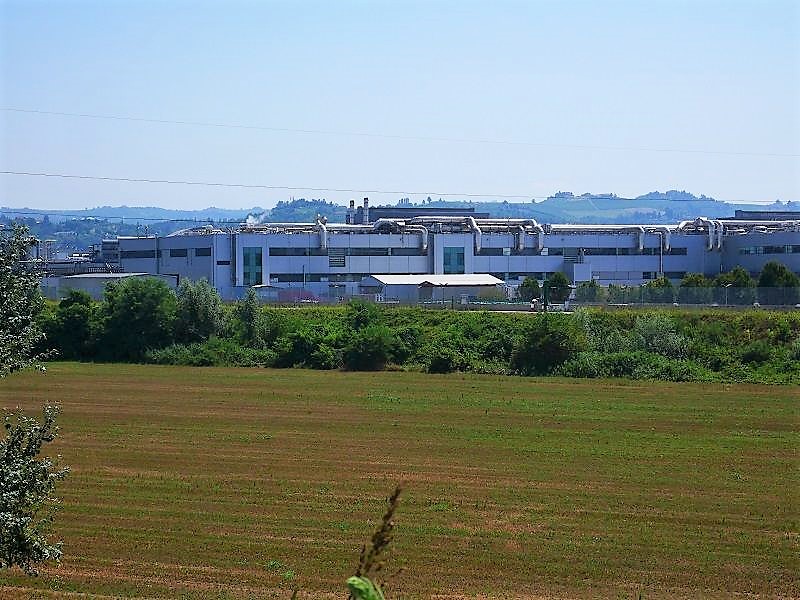
The Origin of the Success of Piedmont’s Chocolate
As Pietro passed away suddenly in 1949, he barely saw the results of his idea. Pietro will always be remembered as the man who turned a pastry shop into a factory and laid down the groundwork for the success of the following decades.
After the death of Pietro, the widow Piera, with a strong managing mindset, was now in charge of the factory, together with Giovanni, the sales talent of the family.
The young Michele, Pietro’s son, joined the team and supervised the production, traveling abroad and hunting for the best ingredients. His passion for industrial technologies brought him to patent his machinery, which made Ferrero a leader in the field.
The result was a production increase and a progressive operation able to make products that required advanced technology. Ferrero succeeded on many occasions, before any other competitor within the confectionery industry.
Each investment and strategy was based on a broad and brave vision, often against anyone else’s opinion. Some examples of this wise entrepreneurship were the decision to compete in foreign markets or to introduce chocolate eggs all year round, beyond the traditional Easter season.
Nonetheless, the idea of selling iced tea in a light and practical takeout package turned out to be a new concept for a summer soda.
From Nutella to Ferrero Rocher
In 1949 jars of spreadable chocolate reached the shelves of groceries. Called “Supercrema”, in 1964 the name was changed to Nutella, with the wider project to conquer the foreign market. The English word nut was combined with the Italian-sounding suffix –ella: a winning marketing strategy.
In a time when all competitors were focusing on hard chocolate bars, Michele Ferrero bet on a soft chocolate and hazelnut spread. As times were changing and chocolate was finally more affordable, Nutella contained more cocoa and cocoa butter than its predecessor Gianduiot.
Numerous commercial hits made Ferrero and Nutella the pride of Alba. Mon Chéri was another example of a name designed to attract international customers. This hard chocolate shell filled with a cherry required the expertise of engineers who had to study how to keep the filling liquid after production.
Ferrero became a popular brand with clever advertising campaigns on television that turned some products into cultural icons.
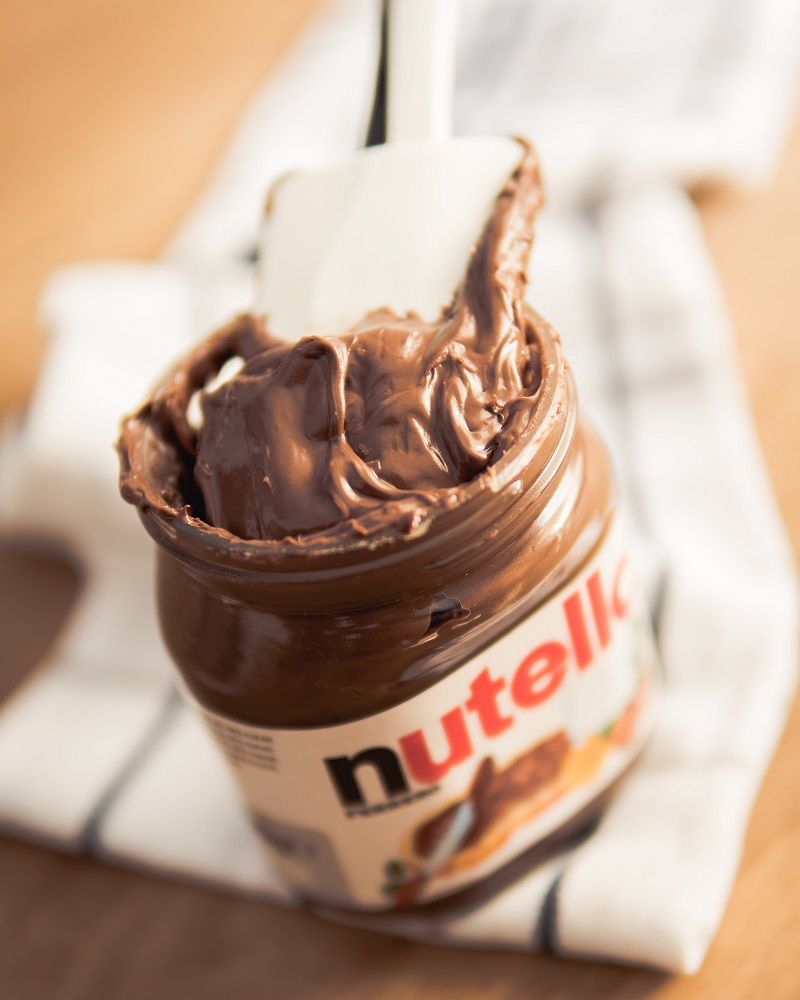
In 1968 the brand Kinder was set to engage with an audience of younger ones. To do so, moms had to be persuaded so milk was advertised as the main ingredient of candies, rather than chocolate, claiming to feed kids with healthy snacks.
That same year Ferrero developed Pocket Coffee, a chocolate shell filled with real liquid espresso coffee, a technique similar to the one of Mon Chéri. In 1969 the Tic Tac mints saw the light and eight years later the summer-iced-tea Estathé came out. Finally, in 1982 Ferrero Rocher golden wraps made it one of the most exported pralines across all continents.
Most products that came out on the market were a huge success back then and they are still popular today. A few others were taken out of production such as the 1953 chocolate bar “Sultanino”. Periodically new confections see the light like the recent Nutella Biscuits which have created a big fuss on the internet.

Ferrero and Nutella Pride and Success of Alba
The expansion of Ferrero turned the Group into a multinational enterprise that is still family-owned. The first plant to be opened over the Alps was in Germany in 1957 and soon after came Belgium, France, and Holland. By the end of the 1970s, Ferrero opened in Asia and Australia.
Today there are 25 factories scattered around the globe.
Trying to tune with local tastes, different versions of the same products were developed. There are certain Ferrero candies available in some countries and not in others.
Decades of growth based on innovation and little debt have lined with the company’s ethical values, aiming to support local communities. For instance, next to the German plant was established “Villa Piera”, a compound of accommodations for workers. The goal was to avoid daily commuting and elevate the employees ‘ lives.
Michele had two sons Pietro and Giovanni, named respectively after his father and uncle. After the unexpected loss of Pietro in 2011, today’s chairman is Giovanni who mainly works from the headquarters in Luxembourg. Following his father’s footsteps, Giovanni Ferrero keeps focusing on its native brands in addition to implementing a new acquisition strategy, such as the recent one with Nestlé.
How the Town of Alba Benefited
In the early 1950s, Ferrero’s sales network was the largest ever seen in Italy at that time. The ongoing success of the Group brought revenue to Alba and the surrounding area, fighting against the depopulation of the Langhe Hills.
A shuttle bus service was introduced to bring workers from the remote villages of the hills to Alba and back home at the end of their shift. It was a significant sustain for workers who could barely afford a car.
In a time when many farmers would consider leaving behind their farms and moving to Turin, aspiring to a full-time job at FIAT’s assembly line, Ferrero was a local source of employment.
New positions opened in the chocolate factory and the office. Moreover, an entire collateral economy gravitated around Ferrero, including new rural activities related to hazelnut crops.

Ferrero Chocolate and the Local Community
What makes Ferrero Group a unique example of a multinational company, is the personal approach with its employees. People in Alba and surrounding areas have great respect for both the employment laid by Ferrero as well as for the family that runs the company.
The Ferrero family has always kept a low-profile lifestyle and avoided gossip despite their social status and that’s something that local people appreciate.
The strong relationship between the Group and the local community goes beyond the job opportunity. A deep sense of respect is rooted in what the factory has given back to Alba since the 1950s.
For many weeks after the death of Michele Ferrero, which occurred in 2015, many shops in Alba displayed a picture of him and a message of gratitude. A simple but touching farewell for a beloved man and a virtual hug to a family to which the town feels related.
Still today, like decades ago, Ferrero focuses on environment-friendly operations, strives for the highest quality, and supports locals.
The Ferrero Foundation
Michele Ferrero founded the Ferrero Foundation in 1983, named after his parents and uncle Giovanni. The sleek and modern building designed by architect Valerio Demaria features an auditorium, gym, and large venues for special events.
At first, the Foundation donated scholarships but in the last decades, it organized art exhibitions of national relevance.
The goal is to give back to the community and, nonetheless, to support retired employees.
Over 3500 former workers and their spouses are entitled to benefit from a list of daily activities, such as sports, cultural events, and travel. An investment to thank people who have contributed to the success of the Group and to let them discover new opportunities during aging.
Are there Guided Tours in Alba’s Ferrero Chocolate Factory
As of April 2023, the Ferrero chocolate factory in Alba has never allowed the general public to enter their premises.
A walking tour of Alba with a local expert includes some locations where this family story began and references to the local social background.
Guests departing from Alba on a Barolo Wine Tour or Truffle Hunt can ask the local guide to stop by the plant’s main entrance with the iconic Ferrero sign. However, only employees are allowed to enter the gates.
The Ferrero Chocolate Outlet Store in Alba
The Ferrero chocolate factory in Alba has an outlet shop open only to employees and to members of law enforcement.
The lean Group communication strategy includes a pullback from the grocery shelves of chocolate candies during the summer months.
As the company aims for high quality, the summer heat compromises the product’s overall condition. Therefore, Ferrero decided not to disappoint their customers by limiting the seasonality of pralines and other candies.
Massive advertisement campaigns are usually set in the fall to inform the audience that Ferrero’s chocolate is back in grocery stores, emphasizing the strive for excellence.



